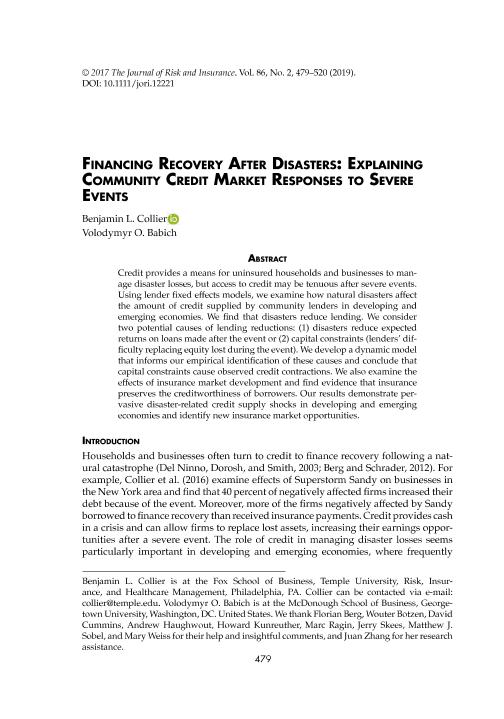Financing recovery after disasters : explaining from property-liability insurance firms

Contenido multimedia no disponible por derechos de autor o por acceso restringido. Contacte con la institución para más información.
| Tag | 1 | 2 | Value |
|---|---|---|---|
| LDR | 00000cab a2200000 4500 | ||
| 001 | MAP20190019675 | ||
| 003 | MAP | ||
| 005 | 20190625125336.0 | ||
| 008 | 190624e20190603usa|||p |0|||b|eng d | ||
| 040 | $aMAP$bspa$dMAP | ||
| 084 | $a32 | ||
| 100 | $0MAPA20090029323$aCollier, Benjamin | ||
| 245 | 0 | 0 | $aFinancing recovery after disasters$b: explaining from property-liability insurance firms$cBenjamin Collier, Volodymyr O. Babich |
| 300 | $a42 p. | ||
| 520 | $aCredit provides a means for uninsured households and businesses to manage disaster losses, but access to credit may be tenuous after severe events. Using lender fixed effects models, we examine how natural disasters affect the amount of credit supplied by community lenders in developing and emerging economies. We find that disasters reduce lending. We consider two potential causes of lending reductions: (1) disasters reduce expected returns on loans made after the event or (2) capital constraints (lenders' difficulty replacing equity lost during the event). We develop a dynamic model that informs our empirical identification of these causes and conclude that capital constraints cause observed credit contractions. We also examine the effects of insurance market development and find evidence that insurance preserves the creditworthiness of borrowers. Our results demonstrate pervasive disaster-related credit supply shocks in developing and emerging economies and identify new insurance market opportunities. | ||
| 650 | 4 | $0MAPA20080600204$aCatástrofes naturales | |
| 650 | 4 | $0MAPA20080586294$aMercado de seguros | |
| 650 | 4 | $0MAPA20080581602$aPaíses emergentes | |
| 650 | 4 | $0MAPA20080624934$aSeguro de daños patrimoniales | |
| 650 | 4 | $0MAPA20080582401$aRiesgo crediticio | |
| 650 | 4 | $0MAPA20080578879$aAnálisis empírico | |
| 700 | 1 | $0MAPA20190008587$aBabich, Volodymyr O. | |
| 773 | 0 | $wMAP20077000727$tThe Journal of risk and insurance$dNueva York : The American Risk and Insurance Association, 1964-$x0022-4367$g03/06/2019 Volumen 86 Número 2 - junio 2019 , p. 479-520 |

